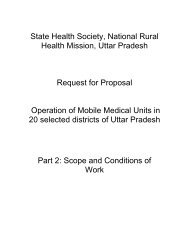MODULE 1: Infection Control and Waste Management - State ...
MODULE 1: Infection Control and Waste Management - State ...
MODULE 1: Infection Control and Waste Management - State ...
Create successful ePaper yourself
Turn your PDF publications into a flip-book with our unique Google optimized e-Paper software.
About this Module -This module focuses upon the importance <strong>and</strong> the purpose of infection prevention. It alsodiscusses the st<strong>and</strong>ard precautions to be maintained while working in health care settings.Unit 1.1Importance <strong>and</strong> Purpose of <strong>Infection</strong> PreventionLearning Objectives:• To appreciate the importance <strong>and</strong> purpose of <strong>Infection</strong> Prevention <strong>and</strong> <strong>Waste</strong><strong>Management</strong> in hospitals.Many of the health care settings have poor infection control <strong>and</strong> fewer infection controlprograms, giving rise to transmission of infections in settings. <strong>Infection</strong> Preventionpractices are important to -• Provide high quality, safe services to clients• Prevent post procedure infections in clients• Prevent infections in service providers <strong>and</strong> staff• Lower the cost of health care facilities• Protect the community from the infections which may occur from health carefacilities. Every one who is present at a health care facility is potentially at the risk ofgetting infections. Not only the doctors <strong>and</strong> nurses, who have direct contact with clients, but thosewho wash instrument, clean, mop <strong>and</strong> dispose waste are also at the equal risk. <strong>Infection</strong> Prevention is everyone’s need <strong>and</strong> responsibility.<strong>Infection</strong> transmission can occur between clients, staff <strong>and</strong> the community by –Client to Health Care Worker – Such transmission can occur through exposure toinfected blood <strong>and</strong> other body fluid:• When a healthcare worker’s skin is pierced or cut by contaminated needles orsharp instruments.• When splashed on mucous membrane (like eyes, nose or mouth) of the health careworker.• Through broken skin due to cuts, scratches, rashes, acne, fungal infections etc.Client to Client – Client to client transmission occurs via indirect routes such as whenhealthcare workers do not wash their h<strong>and</strong>s after some procedure with one Client <strong>and</strong>10










